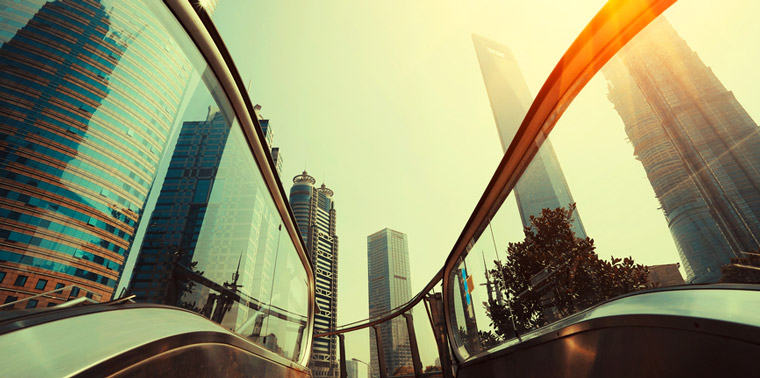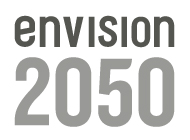June 16, 2014 — By 2050, seven out of every 10 people on Earth will be an urban dweller. What the cities of the future look like depends largely on decisions we make today.
Will we design a future where driverless cars zip around under skyscraping vertical gardens in hyperconnected, energy efficient “smart cities”? Or will we be trapped in endless traffic jams while pollution overwhelms remaining green spaces and infrastructure crumbles?
For this second installment of our Envision 2050 series (read the first here), Ensia turned to five visionary urban planners, designers and architects for their views on what they would like cities to be like in 2050 and what it would take to get there. Here’s what we heard:
Matthew Lynch: Yet to Be Built
Director of sustainable cities with the World Business Council for Sustainable Development
 Nine billion people living well within the limits of the planet by mid-century. That is the simple but powerful “Vision 2050” that the World Business Council for Sustainable Development, or WBCSD, has for the future of humanity.
Nine billion people living well within the limits of the planet by mid-century. That is the simple but powerful “Vision 2050” that the World Business Council for Sustainable Development, or WBCSD, has for the future of humanity.
There is no doubt that sustainable cities are central to this vision. Seventy percent of the world — 7 billion people — will be living in urban areas by 2050. Our cities can be the cornerstone of the green circular economy, supporting resilient societies and inclusive communities with universal access to public services and economic opportunity.
This future is absolutely possible. However, we must act now and take full advantage of the fact that much of our cities and infrastructure is not yet in existence, particularly in the developing world where urban growth is fastest. For example, more than 50 percent of the buildings to support the 300 million more city dwellers in China by 2030 are yet be built. We have a critical one-off window to create compact, mixed-use, transit-oriented urban centers incorporating sustainable, low-carbon infrastructure and prioritizing access and inclusion.
Central to realizing this opportunity is bringing together two of the most powerful forces we have for driving sustainability transformation: the leadership of city governments and the innovation and delivery capacity of the private sector. Building strategic engagement and “co-innovation” between cities and business has been the core focus of the WBCSD’s Urban Infrastructure Initiative, or UII — 14 leading global companies and 10 cities around the world working collaboratively to identify innovative and practical solutions to help cities realize their long-term vision for prosperity and sustainability.
The UII is one of a number of major local and global initiatives that are tackling the key challenges we face in driving a sustainable urban future. I know it is unfashionable these days to be an optimist, but I do believe that Vision 2050 can be a reality.
Tigran Haas: A Major Shift
Associate professor and director of Civitas Athenaeum Laboratory and director of the Ph.D. program in urban and regional studies at KTH Royal Institute of Technology’s School of Architecture and the Built Environment
 The complexities of contemporary global urban, political, economic and environmental issues are evident as we are now confronted with the greatest challenge that we have ever faced. As we move toward 2050 we are facing the consequences of accelerating urbanization and population growth, the rise of mega-cities and mega-regions, the scarcity of natural resources and their mismanagement, the impact of major errors in our responses to disasters, and the increasing demand for and complexity of greatly expanding transportation flows.
The complexities of contemporary global urban, political, economic and environmental issues are evident as we are now confronted with the greatest challenge that we have ever faced. As we move toward 2050 we are facing the consequences of accelerating urbanization and population growth, the rise of mega-cities and mega-regions, the scarcity of natural resources and their mismanagement, the impact of major errors in our responses to disasters, and the increasing demand for and complexity of greatly expanding transportation flows.
Our societies have also undergone rapid and radical shifts in terms of age and class, increasing inequities between the rich and poor and intense demands for democracy in the public realm.
All of this requires immediate solutions but also change of worldviews from architects, urban planners, designers, landscape architects and urbanists. We need these professionals and experts to contribute their most imaginative, pragmatic, resilient, innovative and just solutions.
The way forward is sustainable and resilient cities: energy-efficient neighborhoods and districts and green urbanism, but also civic design that will help shape and organize the city on basis of diversity, human scale and preservation.
Equally important are the new visions for neighborhood housing redevelopment that should support a human, economic, just, social and cultural recovery and renewal.
The systems and processes that we put in place to achieve these ends can be thought of as the software of the community, which includes formal societal services and institutions as well as the community’s informal structure and cultural and social relationships.
For any of this to happen, a major shift and change in habits, customs and adaptation to an uncertain future will be required from all citizens, and without a consensus of all, the vision of a 2050 sustainable and resilient urban world will not be possible.
Luis M. A. Bettencourt: Increasing Understanding
Professor of complex systems at the Santa Fe Institute
 By 2050 most nations on Earth will be highly urbanized, including Africa, parts of Asia and India, where presently only about one-third of the population lives in urban centers. In fact, at a point between now and 2050 some of the largest cities in China and India will surpass Tokyo (currently with 35 million people) as the largest cities in the world.
By 2050 most nations on Earth will be highly urbanized, including Africa, parts of Asia and India, where presently only about one-third of the population lives in urban centers. In fact, at a point between now and 2050 some of the largest cities in China and India will surpass Tokyo (currently with 35 million people) as the largest cities in the world.
Cities in 2050 will continue to perform their primary function as places of intense human interactions (“social reactors,” as I like to call them), but in some ways will look and feel very different from what they look like today — especially those in the developing world. They will have to devise new ways to manage the congestion and the severe environmental impacts that beset them today. They will have to be safer, develop better governance and attract people from all over the world.
Cities at their best are social environments where creativity and human development go hand in hand. The great challenge for cities in the decades to come is to promote universal socioeconomic development that is open-ended and sustainable.
This means achieving many age-old fundamental human aspirations, such as eliminating poverty and creating inclusive societies where equal opportunities are a reality and the “pursuit of happiness” is an attainable goal to everyone.
To be sustainable, this will also mean that we will need new technologies to harness more energy, not less, and to generate it and use it in clean and safe ways, ultimately from fully renewable sources. This, together with improved “cradle-to-cradle” design, would allow us to recycle nearly all of what we consume, generating positive interactions between cities and Earth’s natural environments.
Cities are dynamical environments capable of promoting great change very quickly. The universal attraction of cities today is a sign that this is becoming possible to everyone, especially in developing nations.
In the short term, however, urbanization and development are creating many of the their familiar unintended consequences on a massive scale, including the growth of urban poverty, the severe inadequacy of older political structures, insecurity, and massive pollution and greenhouse gas emissions, with potentially devastating consequences for climate change. Solutions to these problems are best found at the source — in cities.
The greatest obstacle to successful urbanization is our present lack of the understanding of cities. As a consequence, much urban policy is often inadequate, shortsighted and unsustainable.
Through new communication and information technologies and citizen participation, it is now possible to create new types of urban infrastructure to share knowledge about very local conditions at the global scale. In this way, we may be able to cumulate information in a more interdisciplinary body of scientific knowledge about cities and use policy interventions as learning opportunities that transcend local conditions.
Tony Chan: Two Paths
Associate director with design firm Arup
 In China, urbanization is occurring at an unprecedented scale. By the end of 2012, the mainland of the People’s Republic of China had a total urban population of 712 million or 52.6 percent of the total population, rising from 26 percent in 1990. It is projected that 70 percent of the population will live in urban areas by 2035. Over the next two decades China will potentially build 20,000 to 50,000 new skyscrapers and have more than 220 cities with populations of more than 1 million.
In China, urbanization is occurring at an unprecedented scale. By the end of 2012, the mainland of the People’s Republic of China had a total urban population of 712 million or 52.6 percent of the total population, rising from 26 percent in 1990. It is projected that 70 percent of the population will live in urban areas by 2035. Over the next two decades China will potentially build 20,000 to 50,000 new skyscrapers and have more than 220 cities with populations of more than 1 million.
The romantic notion of future cities is that they will be smart, well-connected with zero-emission vehicles, powered by renewable resources and self-sustaining, and have buildings equipped with green technologies while still providing all the fun, excitement and ample economic opportunities for all residents.
However, dystopian future scenarios also exist — where city residents and corporations fight over a resource-constrained world, cities are highly polluted and crime ridden, residents are monitored without any privacy, and there is a chasm of disparity between the have and have-nots.
We see glimpses of both futures in China now. There are cities with magnetic levitation trains able run at over 500 kph, supercapacitor public buses, electric cars and bicycles, smart traffic monitoring systems, LEED Platinum–rated buildings and developments, smart personal devices and sensing technologies, record numbers of wind turbines and solar photovoltaic installations, and numerous eco/smart-cities planned. At the same time, cities in China are experiencing record pollution levels, unprecedented traffic gridlocks, loss of agricultural land and a high number of social protests over loss of resources.
The future of cities and their residents can be either bright or bleak — or both at the same time. To chart the path, many questions will need to be answered: How will cities be powered? Can “waste” resources be utilized? Are buildings and infrastructure resilient enough for climate change? Where will our food come from? Are the needs of all residents being addressed? When does “sensored” become censored? How will the lack of access to new knowledge and digital technology affect the poor and marginalized in terms of economic opportunities? Can we manage the use of resources in cities with the regenerative capacity of the ecosystem?
I think there will be both futures for cities. How we design, set policies, finance, govern and manage these immense challenges will define different futures for different cities.
I am optimistic that there is a great future for most of us in cities and that good design and policies will eventually prevail, but not until after we’ve learned plenty of tough lessons along the way. In order to see the best possible future for all, we have to ensure that everyone has a say rather than just a select few.
Shawn Gehle: Hope for the Future
Principal at the global design firm Gensler
 Contemporary cities have consisted of mostly single-purpose or single-use buildings. In the future I think we’ll see more and more vertical diverse buildings. The Shanghai Tower that we’re currently completing in China is effectively a city within a building. You have multiple uses vertically that are stacked on top of each other. Going vertical is a really fascinating development and I expect we’ll see more of this.
Contemporary cities have consisted of mostly single-purpose or single-use buildings. In the future I think we’ll see more and more vertical diverse buildings. The Shanghai Tower that we’re currently completing in China is effectively a city within a building. You have multiple uses vertically that are stacked on top of each other. Going vertical is a really fascinating development and I expect we’ll see more of this.
The point where buildings become self-sustaining — be it water and power neutral or water and power positive, meaning they give back more resources than they consume — is certainly within the realm of possibility over the next three decades.
No matter where cities are situated, though, I think it’s important that they are resilient to site-specific climate change issues.
I think the cities of tomorrow also need to consider the availability of open space — and not only open space for a select group of people, but open space available to everyone. These spaces provide locations for idea exchange and a shared point of view where people can come together and see themselves as part of a collective community. The retention of open spaces will become increasingly important as land becomes more valuable in and around the center of cities.
Effective urban planning for the future requires vision and will to create something with more vitality than what was there before — proposals with longevity and relevance for generations to come. If we use those as metrics by which we measure success for city building and planning, then we’ll be on the right course. ![]()
Ensia shares solutions-focused stories free of charge through our online magazine and partner media. That means audiences around the world have ready access to stories that can — and do — help them shape a better future. If you value our work, please show your support today.
Yes, I'll support Ensia!


What I was surprised about was that there was no mention of passive design - which goes beyond efficient and carbon neutral. It requires no input once built and because there are virtually no moving parts in passive design, much lower maintenance. I am also surprised that there was no mention on housing sizes where most modern suburban homes are immense and thus wasting mass amounts of resources, not only in their construction, but in their lifespan too. This especially doesn't make sense when families are getting smaller. http://www.patheos.com/blogs/pathsthroughtheforests/2014/09/11/cultural-quandaries-home-design/
There is also the topic of multiple families in a home which is becoming more popular. And how more people are moving toward community shared land as well. http://www.patheos.com/blogs/pathsthroughtheforests/2015/01/05/land-ownership-entitlement-public-private-commons-crown-what-is-the-best-way/